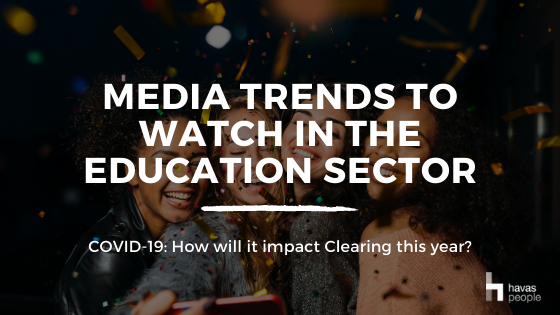WHAT HAS COVID TAUGHT US ABOUT MEDIA CONSUMPTION ACROSS THE EDUCATION SECTOR AND HOW WILL THIS AFFECT CLEARING THIS YEAR?

by TOM PUGH | Published on March 22, 2021
With COVID causing havoc on everything from A-level results days to Open Days and Clearing, the media landscape for education marketing has been reliant on digital more than ever. The Havas 2021 Consumer and Media Trends report highlights that investment across traditional media has been adversely impacted, with a fall for Cinema (-37%), Outdoor (-24.5%), Print (-23%), Radio (-17.4%) and TV (-15.2). As you would expect, the increase in media consumption for in-home media has rocketed. To put this into context, Disney+ achieved in 5 months what took Netflix 7 years! According to a survey by PWC, more than half of global consumers have increased their use of video, messaging apps, and social media, with 74%, 91%, and 86% respectively claiming they are likely to maintain this increased use.
Whilst the end of lockdown is in sight, and we may see a return to previous patterns, what has the COVID experience taught us? With the disruption across the sector in recent months, an increase in the demographic of 18 year olds, and Clearing becoming a more poignant stage of the cycle, will 2021 be ‘business as usual’? Or will the trends initiated or accelerated during the crisis continue to mould consumer behaviour for years to come?
Looking at insight from the Havas Education report, Life Interrupted, a series which looked in detail at the impact of the Coronavirus pandemic on A level students, we can see that students favour a personal touch, or human element in helping them to understand their choices or when considering which university best appeals to them.
Since universities have been so reliant on digital platforms, investment has increased on Facebook, Instagram, Snapchat and the newly emerged Tik Tok. While this follows the trend we have seen before the pandemic, the content itself has adapted. More so than ever the past year has created opportunities for universities to meet consumers when they are at home, providing entertaining content, making connections and being part of the conversation. This development has changed the modus operandi with an explosion of user-generated content across channels, with Tik Tok leading the way by providing that much needed personal human element.
Habits have changed not only on social but also audio. Spotify ended 2020 on a high note by adding a record 74 million subscribers: 30m premium subscribers and a further 44m who signed up for a lower tier over 2020. This influx saw the audio streaming platform grow 27% to reach 345 million members in the fourth quarter. Spotify attributes the surge to a strategy that prioritised podcasts alongside music. This has led to an increase in investment, but also user generated content with podcasts spanning baking to Brexit, and everything in between – highlighting another opportunity universities can tap into to bring meaningful and authentic content to potential students and their influencers.
In summary, a well-placed 6 sheet with a clear call-to-action will always have its place, a relevantly timed radio slot on A-Level results day will certainly raise awareness. But we strongly believe the pandemic has accelerated the change in our media consumption habits for good, highlighting the importance and positive affect of user-generated content and bringing new social channels into focus. For Universities, it will be crucial to be open to these changes and to embrace them in order to reach their audiences where it most matters, with content that is important to them.
